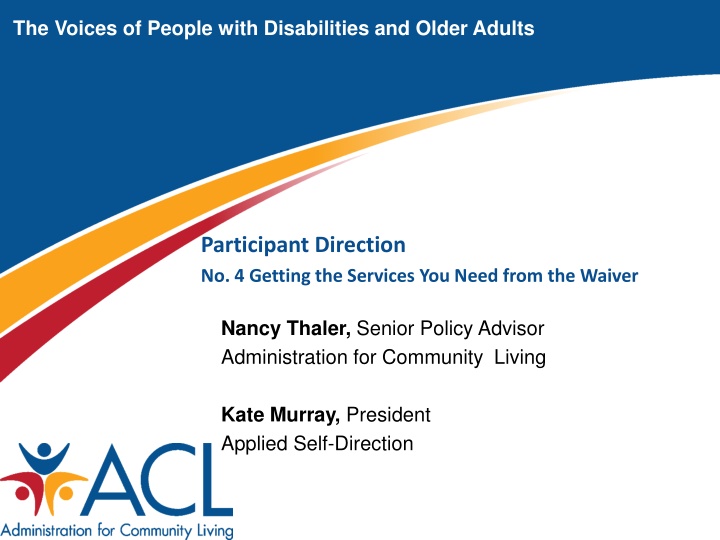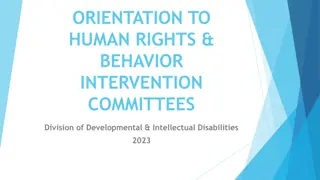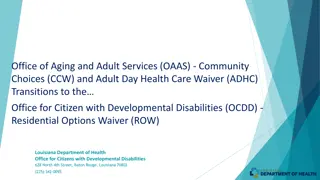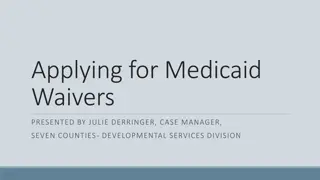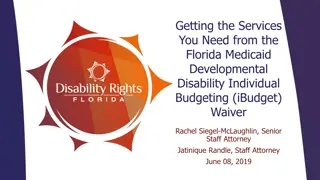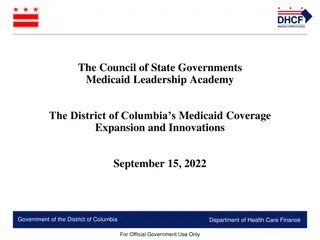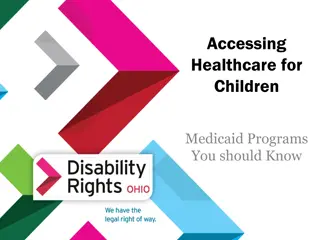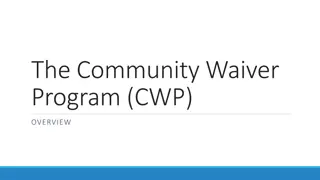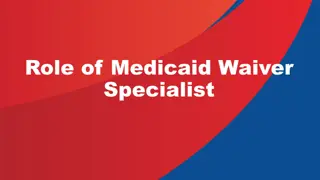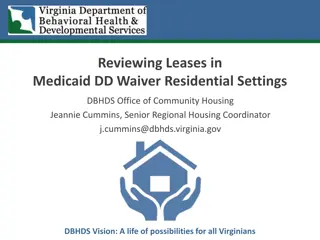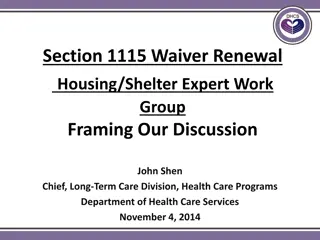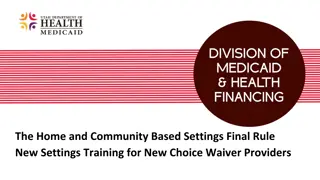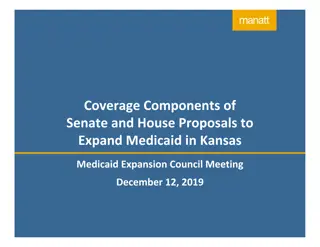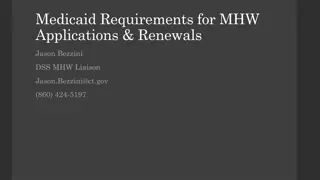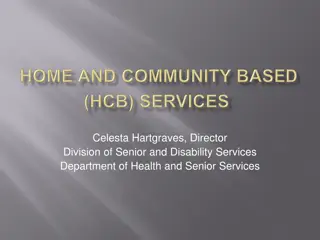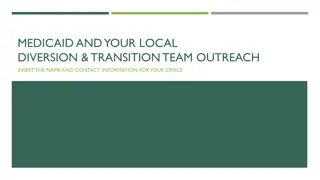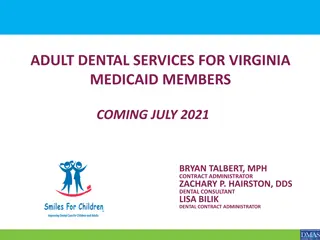Navigating Medicaid Waiver Application for Home and Community Based Services
Delve into the essential aspects of the Medicaid Waiver Application related to participant direction in this informative webinar session. Learn about key considerations, including service provisions, safeguards, and the importance of following HCBS rules to ensure quality care for individuals with disabilities and older adults.
Download Presentation

Please find below an Image/Link to download the presentation.
The content on the website is provided AS IS for your information and personal use only. It may not be sold, licensed, or shared on other websites without obtaining consent from the author.If you encounter any issues during the download, it is possible that the publisher has removed the file from their server.
You are allowed to download the files provided on this website for personal or commercial use, subject to the condition that they are used lawfully. All files are the property of their respective owners.
The content on the website is provided AS IS for your information and personal use only. It may not be sold, licensed, or shared on other websites without obtaining consent from the author.
E N D
Presentation Transcript
The Voices of People with Disabilities and Older Adults Participant Direction No. 4 Getting the Services You Need from the Waiver Nancy Thaler, Senior Policy Advisor Administration for Community Living Kate Murray, President Applied Self-Direction
Webinar Logistics Participants will be muted during this webinar. You can use the chat feature in Zoom to post questions and communicate with the hosts. Toward the end of the webinar, our speakers will have an opportunity to respond to questions that have been entered into chat. The webinar will be live captioned in English. Live English captions can be accessed by clicking the CC button at the bottom of your Zoom screen. 2
Welcome This is 4th in the Administration for Community Living s (ACL) Webinar Series on the role of stakeholders in ensuring high quality in Home and Community Based Services (HCBS) services. In this session we are going to dive into the Medicaid Waiver Application, focusing on the section related to participant direction. 3
Agenda The Medicaid Waiver application an Overview Participant Direction: Appendix E Questions and Answers Closing Comments 4
Why the Waiver Application is Important States describe Who and how many people they will serve What services they will provide and how much What protections are in place Whether people can self-direct and family members can be paid How they will follow the HCBS Rule When CMS approves the application, the state must implement it as approved. Only what is in the waiver can be provided. 5
The Waiver Application Basic Information: Identifies level of care Describes geographic limits Describes public input Signature agreeing to meet the assurances. Appendix D Participant-Centered Service Planning Appendix E Participant Direction Appendix F Rights Appendix A Waiver Administration and Operation Appendix G Safeguards Appendix H Quality Appendix B Access and Eligibility Appendix I Financial Accountability Appendix C Participant Services Appendix J Cost Neutrality
Appendix E: Applicability Appendix E of the waiver application is all about participant direction You can find out if a waiver offers participant-directed services by checking Appendix E 8
Appendix E-1: Overview In Appendix E-1, the state will describe how participant- directed services are designed and how they will operate Waivers can offer employer authority, budget authority, or both 9
Employer and Budget Authority Employer Authority Participants recruit, hire, supervise and direct the workers who furnish supports. Budget Authority Participants manage a flexible budget. Can set rates of pay for staff May be able to use budget to purchase goods and non- employee services 10
Introducing Participant Direction States must describe how participants are informed about participant direction, when they are informed, and who informs them 11
Appendix E-1-f: Use of Representatives The waiver will show whether a participant can appoint a representative to handle some or all employer duties on their behalf Nearly all states allow for using representatives 12
Appendix E-1-g: What Services Can Be Self-Directed? Appendix E-1-g shows every waiver service that can be self-directed The table also shows whether each service has employer authority, budget authority, or both 13
Appendix E-1-h: Financial Management Services (FMS) 14
Appendix E-1-j: Information and Assistance in Support of Participant Direction States are required to provide or arrange for a system of supports and assistance in developing the person-centered service plan and budget plan, managing the individual's services and workers and performing the responsibilities of an employer. 15
Appendix E-1-k: Independent Advocacy Independent advocacy is not required in a waiver, but states can choose to offer it. Independent advocacy can be provided in multiple ways. Some common ways include a support broker, a paid advocate working on behalf of an advocacy organization, and/or a peer support specialist. 16
Appendix E-1-l: Voluntary Termination of Participant Direction Participant direction is always an option participants are never required to self-direct Participants can disenroll at any time States must have processes in place to ensure service continuity for participants who no longer want or are able to self-direct 17
Appendix E-1-m: Involuntary Termination of Participant Direction Usually takes place due to issues related to health and safety, or not following program rules States must still ensure service continuity and prevent service disruption if someone is involuntarily disenrolled 18
Appendix E-2: Opportunities for Participant Direction States can structure the employment relationship differently in self-direction The participant (or representative) can be the sole employer of their workers, or can co-employ workers alongside an agency States can select one or both options 19
Appendix E-2-b: Budget Authority When a waiver offers budget authority, the state must describe the methodology used to calculate participants budgets Also must describe process for how participants are notified of their budget amount 20
Appendix E-2-b Budget Authority States have the option to require that a participant s service plan must be changed before the participant can modify the services they spend their budget on In waivers with especially flexible budget authority, the participant can change the services they purchase with their budget without changing their service plan first 21
Kate Murray, President kate@appliedselfdirection.com https://www.appliedselfdirection.com/our- team 22
Why the Waiver Application is Important? States describe Who they will serve and how many people What services they will provide and how much What protections are in place Whether people can self-direct and family members can be paid How they will follow the HCBS Rule When CMS approves it, the state must implement it as approved. Only what is in the waiver can be provided. CMS expects there will be public input. 23
How You Can Influence What Services are in the Waiver Get copies of the proposed application and distribute it to others Hold discussion sessions about the proposed services as compared to what people need Show up in person and give public comment ask questions Ask for a meeting with the state agency to learn more about the application Submit written comments from your organization Coordinate templates for others to use in submitting comments Consult partners about submitting join comments 24
State Waiver Applications Access proposed and approved waivers for all states at https://www.medicaid.gov/medicaid/section-1115-demo/demonstration-and-waiver- list/index.html?f%5B0%5D=waiver_state_facet%3A991#content#content Access the application form, technical guide and other related materials at CMS Waiver Applications Portal: https://www.medicaid.gov/medicaid/home-community-based-services/home-community- based-services-authorities/home-community-based-services-1915c/index.html Click on 1915(c) Waiver Application in the box on the right On the left click on 1915(c) Application download version. Will download as a zip file. 25
Please put any questions in the chat Thank you. 26
